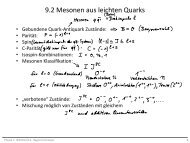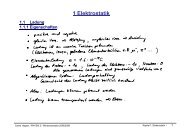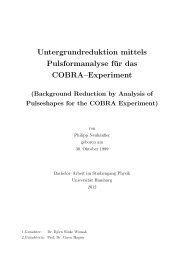Setup of a Drift Tube Muon Tracker and Calibration of Muon ...
Setup of a Drift Tube Muon Tracker and Calibration of Muon ...
Setup of a Drift Tube Muon Tracker and Calibration of Muon ...
You also want an ePaper? Increase the reach of your titles
YUMPU automatically turns print PDFs into web optimized ePapers that Google loves.
510Counts/(10 keV x day x 100 tons)410310210101-110-210Fit: χ 2 /NDF = 185/1747Be: 49±3 cpd/100 tons210Bi+CNO: 23±2 cpd/100 tons85Kr: 25±3 cpd/100 tons11C: 25±1 cpd/100 tons14C10C-310200 400 600 800 1000 1200 1400 1600 1800 2000Energy [keV]Figure 4.6: Fitted Borexino Data taken from [69]. The black data points alreadyinclude all relevant cuts. The Figure does not include contributions from 214 PB, pp,<strong>and</strong> pep neutrinos which are almost negligible. Again, the Compton like edge for the7 Be neutrinos can be clearly seen (red line). The fit result gives a rate <strong>of</strong> 49 ±3 countsper day. For the 11 C background, a rate <strong>of</strong> 25 ± 1 is found.100 tons.For the analysis, events were chosen by a selection <strong>of</strong> cuts. A fiducial volume<strong>of</strong> 78.5 tons was chosen to reject external gamma background. Furthermore, eventswithin 2 ms after a crossing muon were rejected to suppress events from the decay <strong>of</strong>short living cosmogenic induced radionuclides. Decays due to radon daughters couldbe removed by vetoing 214 Bi– 214 Po coincidences. Events from the α decay <strong>of</strong> 210 Pocould be identified through pulse shape discrimination <strong>and</strong> were subtracted fromthe spectrum. The raw photo electron spectrum after these basic cuts is shown inFig. 4.5. The Compton-like edge from the reaction <strong>of</strong> 7 Be neutrinos is clearly visiblearound 300 photo-electrons. Below 100 photo electrons, the spectrum is dominatedby the decay <strong>of</strong> 14 C. Furthermore, the impact <strong>of</strong> the β + decay <strong>of</strong> 11 C can be seen inthe region between 400 <strong>and</strong> 800 photo electrons (cf. Section. 4.3.3).Fig. 4.6 shows the spectral fit <strong>of</strong> the data. For the 7 Be neutrinos, a rate <strong>of</strong> 49 ±3events per day <strong>and</strong> 100 tons is found. The high metallicity SSM predicts a rate<strong>of</strong> 74 ± 4 counts per day <strong>and</strong> 100 tons for no oscillations whereas the MSW-LMAscenario (assuming ∆m 2 12 = 7.6−5 eV 2 <strong>and</strong> sin 2θ 12 = 0.87) reduces this expectationto 48±4 counts per day per 100 tons. Hence, the results confirm the matter enhancedoscillation hypothesis.To test solar models, the measured neutrino flux is compared to the prediction<strong>of</strong> the SSM. The measurements also give new constrains to the ratio f Be between the7 Be neutrinos flux predicted by the high metallicity SSM <strong>and</strong> the measured value,where f is defined as the true solar neutrino flux divided by the corresponding value<strong>of</strong> the fluxes predicted by the according solar model. For the MSW-LMA oscillationscenario, a value <strong>of</strong> f Be = 1.02±0.10 is obtained. The analysis ales gives a constraintfor the ratio f CNO for CNO neutrinos <strong>of</strong> f CNO < 3.80 <strong>and</strong> a value f pp for pp neutrinos<strong>of</strong> f pp = 1.005 +0.008−0.020 . The constraint on f CNO translates into a CNO contribution <strong>of</strong>62





